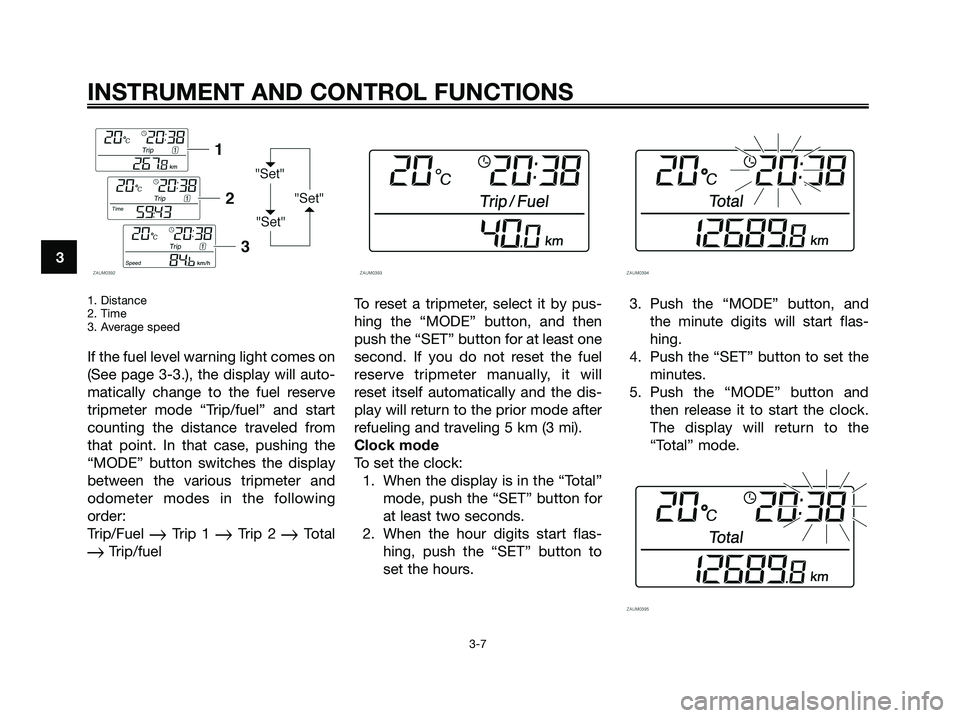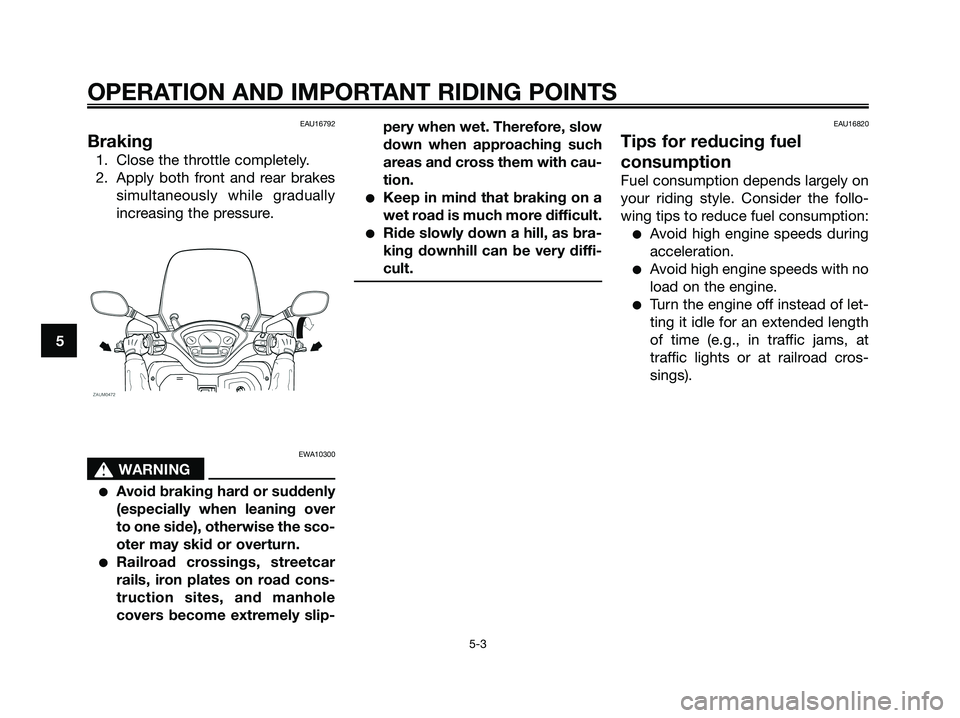Page 22 of 88

1. Distance
2. Time
3. Average speed
If the fuel level warning light comes on
(See page 3-3.), the display will auto-
matically change to the fuel reserve
tripmeter mode “Trip/fuel” and start
counting the distance traveled from
that point. In that case, pushing the
“MODE” button switches the display
between the various tripmeter and
odometer modes in the following
order:
Trip/Fuel
�Trip 1 �Trip 2 �Total
�Trip/fuelTo reset a tripmeter, select it by pus-
hing the “MODE” button, and then
push the “SET” button for at least one
second. If you do not reset the fuel
reserve tripmeter manually, it will
reset itself automatically and the dis-
play will return to the prior mode after
refueling and traveling 5 km (3 mi).
Clock mode
To set the clock:
1. When the display is in the “Total”
mode, push the “SET” button for
at least two seconds.
2. When the hour digits start flas-
hing, push the “SET” button to
set the hours.3. Push the “MODE” button, and
the minute digits will start flas-
hing.
4. Push the “SET” button to set the
minutes.
5. Push the “MODE” button and
then release it to start the clock.
The display will return to the
“Total” mode.
INSTRUMENT AND CONTROL FUNCTIONS
3-7
3
1C0-F8199-E4.qxd 22/11/07 05:41 Página 22
Page 24 of 88

EAU12331
Anti-theft alarm (optional)
This model can be equipped with an
optional anti-theft alarm by a Yamaha
dealer. Contact a Yamaha dealer for
more information.
EAU12347
Handlebar switches
1. Start switch “g”
2. Hazard switch“”
1. Dimmer switch “
j/k”
2. Pass switch “PASSING”
3. Turn signal switch “
c/d”
4. Horn switch “a”
EAUS1020
Dimmer switch “j/k”
Set this switch to “
j” for the high
beam and to “
k” for the low beam.
With the headlight on low beam,
press this switch downwards to flash
the headlight.
EAU12460
Turn signal switch “c/d”
To signal a right-hand turn, push this
switch to “
d”. To signal a left-hand
turn, push this switch to “
c”. When
released, the switch returns to the
center position. To cancel the turn
signal lights, push the switch in after it
has returned to the center position.
EAU12500
Horn switch “a”
Press this switch to sound the horn.
EAUM1990
Hazard switch “ ”, “h”
With the key in the “ON” position, set
this switch to “ ” to turn on the
hazard lighting (simultaneous flashing
of all turn signal lights). To turn off the
hazard lighting, set this switch to “h”
and, then turn the key to “OFF”.
INSTRUMENT AND CONTROL FUNCTIONS
3-9
3
1C0-F8199-E4.qxd 22/11/07 05:41 Página 24
Page 25 of 88

NOTE:
Even if the key is turned from “ON” to
“OFF” with the hazard lighting on, the
hazard lighting will continue to flash
regardless of the hazard switch posi-
tion. To cancel the hazard lighting, the
key must be turned to “ON” and the
hazard switch must be set to the “h”
position.
The hazard lighting is used in case of
an emergency or to warn other drivers
when your scooter is stopped where
it might be a traffic hazard.
ECA10060
CAUTION:
Do not use the hazard light for an
extended length of time, otherwise
the battery may discharge.
EAU12720
Start switch “g”
With the sidestand up, push this
switch while applying the front or rear
brake to crank the engine with the
starter.
ECA10050
CAUTION:
See page 5-1 for starting instruc-
tions prior to starting the engine.
EAU12900
Front brake lever
1. Front brake lever
The front brake lever is located on the
right handlebar grip. To apply the
front brake, pull this lever toward the
handlebar grip.
EAU12950
Rear brake lever
1. Rear brake lever
The rear brake lever is located on the
left handlebar grip. To apply the rear
brake, pull this lever toward the hand-
lebar grip.
INSTRUMENT AND CONTROL FUNCTIONS
3-10
3
1C0-F8199-E4.qxd 22/11/07 05:41 Página 25
Page 33 of 88

EWA10240
s s
WARNING
The vehicle must not be ridden with
the sidestand down, or if the sides-
tand cannot be properly moved up
(or does not stay up), otherwise the
sidestand could contact the ground
and distract the operator, resulting
in a possible loss of control. Yama-
ha’s ignition circuit cut-off system
has been designed to assist the
operator in fulfilling the responsibi-
lity of raising the sidestand before
starting off. Therefore, check this
system regularly as described
below and have a Yamaha dealer
repair it if it does not function pro-
perly.
EAU15372
Ignition circuit cut-off
system
The ignition circuit cut-off system
(comprising the sidestand switch and
brake light switches) has the following
functions.
●It prevents starting when the
sidestand is up, but neither brake
is applied.
●It prevents starting when either
brake is applied, but the sides-
tand is still down.
●It cuts the running engine when
the sidestand is moved down.
Periodically check the operation of
the ignition circuit cut-off system
according to the following procedure.
EWA10250
s s
WARNING
If a malfunction is noted, have a
Yamaha dealer check the system
before riding.
INSTRUMENT AND CONTROL FUNCTIONS
3-18
3
1C0-F8199-E4.qxd 22/11/07 05:41 Página 33
Page 37 of 88
ITEM CHECKS PAGE
Brake levers• Make sure that operation is smooth.
• Lubricate lever pivoting points if necessary.3-10, 6-18
Centerstand, sidestand• Make sure that operation is smooth.
• Lubricate pivots if necessary.6-22
Chassis fasteners• Make sure that all nuts, bolts and screws are properly tightened.
• Tighten if necessary.—
Instruments, lights, signals • Check operation.
and switches• Correct if necessary.—
Sidestand switch• Check operation of ignition circuit cut-off system.
• If system is defective, have Yamaha dealer check vehicle.3-17~3-19
PRE-OPERATION CHECKS
4-3
4
1C0-F8199-E4.qxd 22/11/07 05:41 Página 37
Page 38 of 88

EAU15980
EWA10870
s s
WARNING
●Become thoroughly familiar
with all operating controls and
their functions before riding.
Consult a Yamaha dealer
regarding any control or func-
tion that you do not thoroughly
understand.
●Never start the engine or ope-
rate it in a closed area for any
length of time. Exhaust fumes
are poisonous, and inhaling
them can cause loss of cons-
ciousness and death within a
short time. Always make sure
that there is adequate ventila-
tion.
●For safety, always start the
engine with the centerstand
down.
EAUM2230
Starting the engineECA10250
CAUTION:
See page 5-4 for engine break-in
instructions prior to operating the
vehicle for the first time.
In order for the ignition circuit cut-off
system to enable starting, the sides-
tand must be up.
EWA10290
s s
WARNING
●Before starting the engine,
check the function of the igni-
tion circuit cut-off system
according to the procedure
described on page 3-18.
●Never ride with the sidestand
down.
1. Turn the key to “ON”.ECAM1080
CAUTION:
The following warning lights and
indicator light should come on for a
few seconds, then go off.
●Fuel level warning light
●Engine trouble warning light
●Immobilizer system indicator
lightIf a warning or indicator light does
not go off, see page 3-3 for the
corresponding warning and indica-
tor light circuit check.
2. Close the throttle completely.
3. Start the engine by pushing the
start switch while applying the
front or rear brake.
1. Rear brake lever
2. Start switch
3. Front brake lever
NOTE:
If the engine does not start, release
the start switch, wait a few seconds,
and then try again. Each starting
attempt should be as short as possi-
ble to preserve the battery. Do not
123
ZAUM0649
OPERATION AND IMPORTANT RIDING POINTS
5-1
5
1C0-F8199-E4.qxd 22/11/07 05:41 Página 38
Page 40 of 88

EAU16792
Braking
1. Close the throttle completely.
2. Apply both front and rear brakes
simultaneously while gradually
increasing the pressure.
EWA10300
s s
WARNING
●Avoid braking hard or suddenly
(especially when leaning over
to one side), otherwise the sco-
oter may skid or overturn.
●Railroad crossings, streetcar
rails, iron plates on road cons-
truction sites, and manhole
covers become extremely slip-pery when wet. Therefore, slow
down when approaching such
areas and cross them with cau-
tion.
●Keep in mind that braking on a
wet road is much more difficult.
●Ride slowly down a hill, as bra-
king downhill can be very diffi-
cult.
EAU16820
Tips for reducing fuel
consumption
Fuel consumption depends largely on
your riding style. Consider the follo-
wing tips to reduce fuel consumption:
●Avoid high engine speeds during
acceleration.
●Avoid high engine speeds with no
load on the engine.
●Turn the engine off instead of let-
ting it idle for an extended length
of time (e.g., in traffic jams, at
traffic lights or at railroad cros-
sings).
OPERATION AND IMPORTANT RIDING POINTS
5-3
5
1C0-F8199-E4.qxd 22/11/07 05:41 Página 40
Page 46 of 88

ODOMETER READING
ANNUAL
NO. ITEM CHECK OR MAINTENANCE JOB
1000 km 10000 km 20000 km 30000 km 40000 kmCHECK
(600 mi) (6000 mi) (12000 mi) (18000 mi) (24000 mi)
• Change. (See page 6-9.)√When the oil change indicator light 20Engine oilcomes on (every 3000 km (1800 mi))
• Check oil level and vehicle for oil leakage. Every 3000 km (1800 mi)√
21 *Engine oil strainer• Clean.√
22Final transmission oil• Check vehicle for oil leakage.√√ √• Change.√√√
23 *V-belt• Replace. Every 20000 km (12000 mi)
24 *Front and rear brake
• Check operation.√√√√√ √
switches
25Moving parts and cables• Lubricate.√√√√ √
Throttle grip housing• Check operation and free play.
26 * • Adjust the throttle cable free play if necessary.√√√√ √
and cable
• Lubricate the throttle grip housing and cable.
27 *Lights, signals • Check operation.
and switches• Adjust headlight beam.√√√√√ √
PERIODIC MAINTENANCE AND MINOR REPAIR
6-5
6
EAU18670
NOTE:
●The air filter needs more frequent service if you are riding in unusually wet or dusty areas.
●Hydraulic brake service
• Regularly check and, if necessary, correct the brake fluid level.
• Every two years replace the internal components of the brake master cylinders and calipers, and change the bra-
ke fluid.
• Replace the brake hoses every four years and if cracked or damaged.
1C0-F8199-E4.qxd 22/11/07 05:41 Página 46